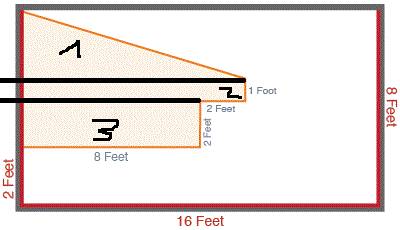
Mathematics, 16.09.2019 10:50 wildfire771003
The figure below shows a shaded region and a nonshaded region. angles in the figure that appear to be right angles are right angles.
a picture of a rectangle is shown. the bottom of the rectangle is labeled 16 ft. the right side of the rectangle is labeled 8 ft. at the bottom left side of the rectangle there is a label that reads 2 ft. inside the rectangle is a shaded region. the bottom of the region is labeled 8 ft and this side is perpendicular to the left side of the rectangle. the right side of the shaded region has a perpendicular line segment extending upward that is labeled 2 ft. at the top of this line segment is another line segment perpendicular to the right that reads 2 ft. at the end of this line segment is a perpendicular line segment extending upward that reads 1 ft. there is a line segment joining the end of this line segment with the top left corner of the rectangle.
what is the area, in square feet, of the shaded region?
enter your answer in the box. square feet
what is the area, in square feet, of the nonshaded region?
enter your answer in the box. square fee

Answers: 1


Another question on Mathematics

Mathematics, 21.06.2019 15:30
Will used 20 colored tiles to make a design in art class. 5/20 of his tiles were red. what is an equivalent fraction for the red tiles?
Answers: 1

Mathematics, 21.06.2019 18:30
The volume of gas a balloon can hold varies directly as the cube of its radius. imagine a balloon with a radius of 3 inches can hold 81 cubic inches of gas. how many cubic inches of gas must be released to reduce the radius down to 2 inches?
Answers: 1

Mathematics, 21.06.2019 18:40
Airplane speeds are measured in three different ways: (1) indicated speed, (2) true speed, and (3) ground speed. the indicated airspeed is the airspeed given by an instrument called an airspeed indicator. a plane’s indicated airspeed is different from its true airspeed because the indicator is affected by temperature changes and different altitudes of air pressure. the true airspeed is the speed of the airplane relative to the wind. ground speed is the speed of the airplane relative to the ground. for example, a plane flying at a true airspeed of 150 knots into a headwind of 25 knots will have a ground speed of 125 knots. the problems below refer to static and dynamic pressure. static pressure is used when a body is in motion or at rest at a constant speed and direction. dynamic pressure is used when a body in motion changes speed or direction or both. a gauge compares these pressures, giving pilots an indicated airspeed. in problem #s 1 and 2, use the following information. the indicated airspeed s (in knots) of an airplane is given by an airspeed indicator that measures the difference p (in inches of mercury) between the static and dynamic pressures. the relationship between s and p can be modeled by s=136.4p√+4.5. 1. find the differential pressure when the indicated airspeed is 157 knots. 2. find the change in the differential pressure of an airplane that was traveling at 218 knots and slowed down to195 knots. in problem #s 3 and 4, use the following information. the true airspeed t (in knots) of an airplane can be modeled by t=(1+a50,000) ⋅ s, where a is the altitude (in feet) and s is the indicated airspeed (in knots). 3. write the equation for true airspeed t in terms of altitude and differential pressure p. 4. a plane is flying with a true airspeed of 280 knots at an altitude of 20,000 feet. estimate the differential pressure. explain why you think your estimate is correct.
Answers: 2

Mathematics, 21.06.2019 21:00
Bo is buying a board game that usually costs bb dollars. the game is on sale, and the price has been reduced by 18\%18%. what could you find the answer?
Answers: 1
You know the right answer?
The figure below shows a shaded region and a nonshaded region. angles in the figure that appear to b...
Questions


English, 29.08.2019 19:00



History, 29.08.2019 19:00



History, 29.08.2019 19:00




Computers and Technology, 29.08.2019 19:00












